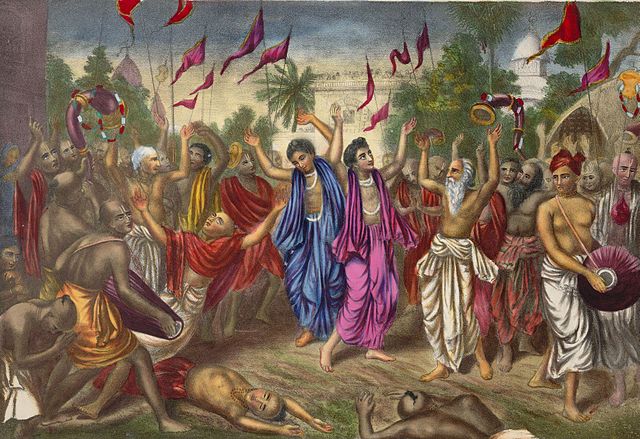Top Qs
Timeline
Chat
Perspective
Nityananda
Hindu saint (born c. 1474) From Wikipedia, the free encyclopedia
Remove ads
Nityananda (Bengali: নিত্যানন্দ, IAST: Nityānanda; c. 1474-c. 1540), also called Nityananda Prabhu and Nitai, was a primary religious figure within the Gaudiya Vaishnava tradition of Bengal. Nityananda was Chaitanya Mahaprabhu's friend and disciple. Chaitanya and Nityananda are often mentioned together as Gaura-Nitai (Gaura, referring to Chaitanya) or Nimai-Nitai (Nimai being a name of Chaitanya).[1]
This article needs additional citations for verification. (April 2017) |
According to Gaudiya-Vaishnava tradition, Nityananda is Balarama Himself (so is also called Nityananda Rama, where Rama refers to Balarama), with Chaitanya being His eternal brother and friend, Krishna.[2] Chaitanya is considered the "most merciful" incarnation of Krishna as Svayam bhagavan.[3]
Bhaktisiddhanta Sarasvati, the early 20th-century Gaudiya-Vaishnava reformer, writes about Nityananda's theological position as the embodiment of the mercy of the guru: "Nityananda is the Primary Manifestive Constituent of the Divinity.[clarification needed] Nityananda alone possesses the distinctive function of the guru. In Nityananda, the function is embodied. Nityananda is the servant-God."[4]
Remove ads
Life
Summarize
Perspective
This section needs additional citations for verification. (May 2021) |

Nityananda was born to a religious Bengali Brahmin called Pandit Hadai, and his wife, Padmavati,[5] in Ekachakra[6] around 1474. His devotion and great talent for singing Vaishnava hymns (bhajan) were apparent from a very early age. In his youth, he generally played the part of Lakshman, the god Rama's younger brother, in dramatic re-enactments of Rama's pastimes, along with the other boys of Ekachakra.[citation needed]
At the age of thirteen, Nityananda left home with a travelling renunciate (sannyasi) known as Lakshmipati Tirtha. Nityananda's father, Hadai, offered Lakshmipati anything he wished as a gift, who replied that he was in need of someone to assist him in his travels to the holy places, and that Nityananda would be perfect for the job. As he had given his word, Hadai agreed, and Nityananda joined Lakshmipati in his travels. Apart from Lakshmipati, who at some point initiated him, Nityananda was also associated with Lakshmipati's other disciples: Madhavendra Puri, Advaita Acharya, and Ishvara Puri, the spiritual master of Chaitanya Mahaprabhu.[citation needed]
He died sometime between the years 1540 and 1544.[7]
Marriage and descendants

Nityananda married two daughters of Suryadasa Sarakhela: Vasudha and Jahnava Devi with the help of Uddharan Dutta Thakura of Saptogram. After marriage, he settled in Khardaha, 24 Parganas, West Bengal. He had a son, Virachandra Goswami or Virabhadra (who was later initiated to Vaishnava rites by his co-mother Jahnava Devi) and a daughter, Ganga, by his first wife, Vasudha.[8]
Remove ads
Legacy
Chaitanya and Nityananda's deeds have deep religious and cultural implications in Bengal. They are credited with the revival of Hinduism in Eastern India. Much of Vaishnava literature, regarded as one of the finest literary heritages of medieval Bengal, came from them or their disciples. Chief among Nityananda's disciples were the Twelve Gopalas, who spread the faith throughout the region.
Remove ads
See also
References
External links
Wikiwand - on
Seamless Wikipedia browsing. On steroids.
Remove ads

